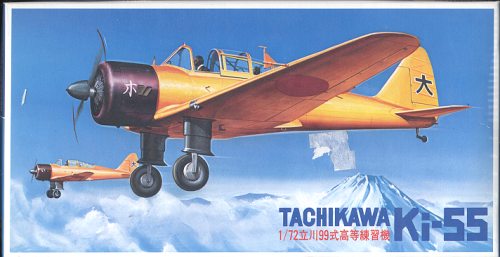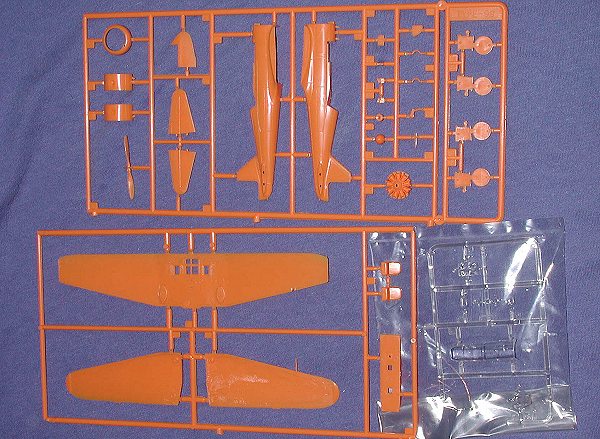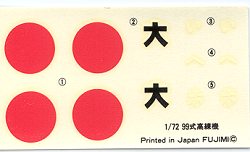
|
KIT: |
Fujimi 1/72 Ki-55 |
|
KIT # |
7A-A1 |
|
PRICE: |
$? |
|
DECALS: |
Three aircraft |
|
REVIEWER: |
|
|
NOTES: |

|
HISTORY |
Tachikawa's Ki-55 is basically a 'de-militarized' version of their Ki-36 light bomber. All of the offensive armament, bomb racks and the lower gear spats were removed from the Ki-36 and a second set of controls added to the back seat to make the Ki-55. In all other respects, the airframe is identical to the Ki-36.
The reason for this was that the Ki-36 proved to be an extremely tractable aircraft with almost no vices (other than being a tad slow). As the Japanese were in need of an advanced trainer, the choice was obvious. Since most of the development was already done, the plane was quickly put into production by both Tachikawa and Kawasaki as the Type 99 advanced trainer. It was operated by both Army training schools and by those flight schools under contract to the Army. The type was also used by the various Japanese 'satellite' countries, such as Thailand, Manchukuo, and Cochin China. It was also used post-war by the Indonesians in their war against the Dutch as there were several training schools in the Dutch East Indies during the war. To my knowledge, Indonesia has the only extant example of this type.
|
THE KIT |

If you are into easy to build models and bright plastic, then this is a kit for you. In nearly all respects, it is the same kit as the Ki-36, however, it has swapped out the spatted wheels for the open ones as shown on the box art. The parts are very well molded and are nicely engraved. Fabric representation on the control surfaces is well done. A false engine front is provided as a full engine really isn't needed. The clear bits are well molded and quite transparent. The canopy can only be built in the closed position; no real problem as the cockpit is rather minimal, a trait common on today's 1/72 kits as well as ones like this molded in 1983! I'm unsure if there are any aftermarket bits for it and would be surprised if Eduard didn't at least do an etched brass interior for it!
Instructions are quite simple and mostly in Japanese. They do
instruct the builder to drill a hole in the back for the extra control stick,
but mention nothing about filling in the lower observation windows (which were
not included in the Ki-55 trainer). I guess you could just install them and
paint over them, but most of us will fill in the joins. Construction should
proceed quite quickly as the number of parts is small. Decals are for three
aircraft, all of them painted overall trainer
 orange with "cocoa brown" cowling
and upper gear covers. I'm not really too sure about that brown color, but with
so little reference on the type, I'd tend to go with the instructions. The only
difference between the three aircraft is the character decal that goes on the
cowling. In all respects they are the same. An adventurous modeler will try to
scrounge some markings to do a Thai, Manchukuo, Cochin Chinese, or Indonesian
aircraft. The kit decals themselves are typical of Japanese kit decals of the
time being rather thick and with ivory vice white markings. Despite being 20
years old, I'm sure they will work. Besides, one has little other choice!
orange with "cocoa brown" cowling
and upper gear covers. I'm not really too sure about that brown color, but with
so little reference on the type, I'd tend to go with the instructions. The only
difference between the three aircraft is the character decal that goes on the
cowling. In all respects they are the same. An adventurous modeler will try to
scrounge some markings to do a Thai, Manchukuo, Cochin Chinese, or Indonesian
aircraft. The kit decals themselves are typical of Japanese kit decals of the
time being rather thick and with ivory vice white markings. Despite being 20
years old, I'm sure they will work. Besides, one has little other choice!
|
CONCLUSIONS |
From my experience building the Ki-36, I can tell you that it will be a quick and painless build. Something quite appropriate for a new modeler and those of us who want a pleasant build of an unusual subject.
|
REFERENCES |
Japanese Aircraft of the Pacific War, RJ Francillon, 1979
If you would like your product reviewed fairly and quickly by a site that has well over 175,000 visitors a month, please contact me or see other details in the Note to Contributors.